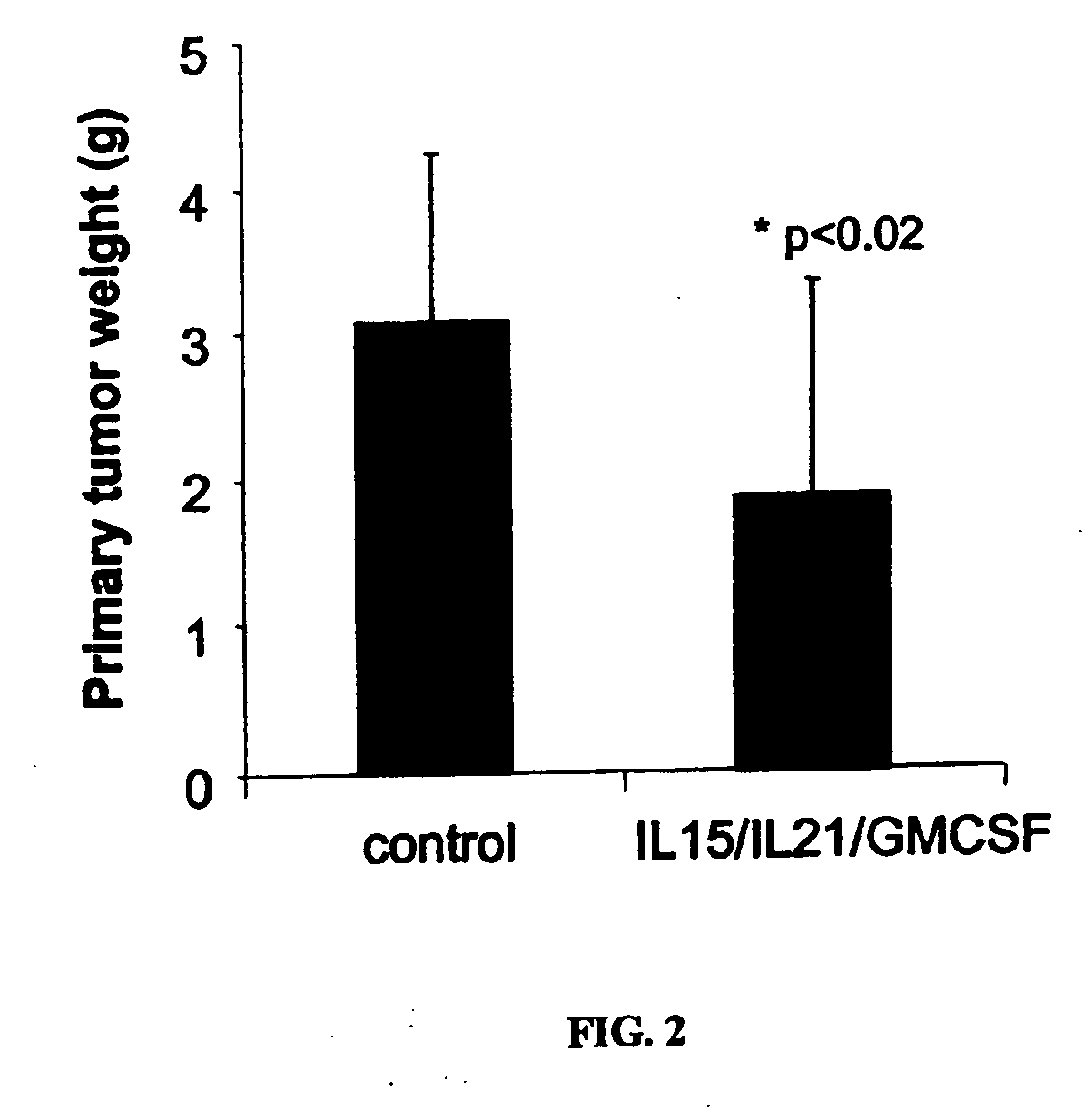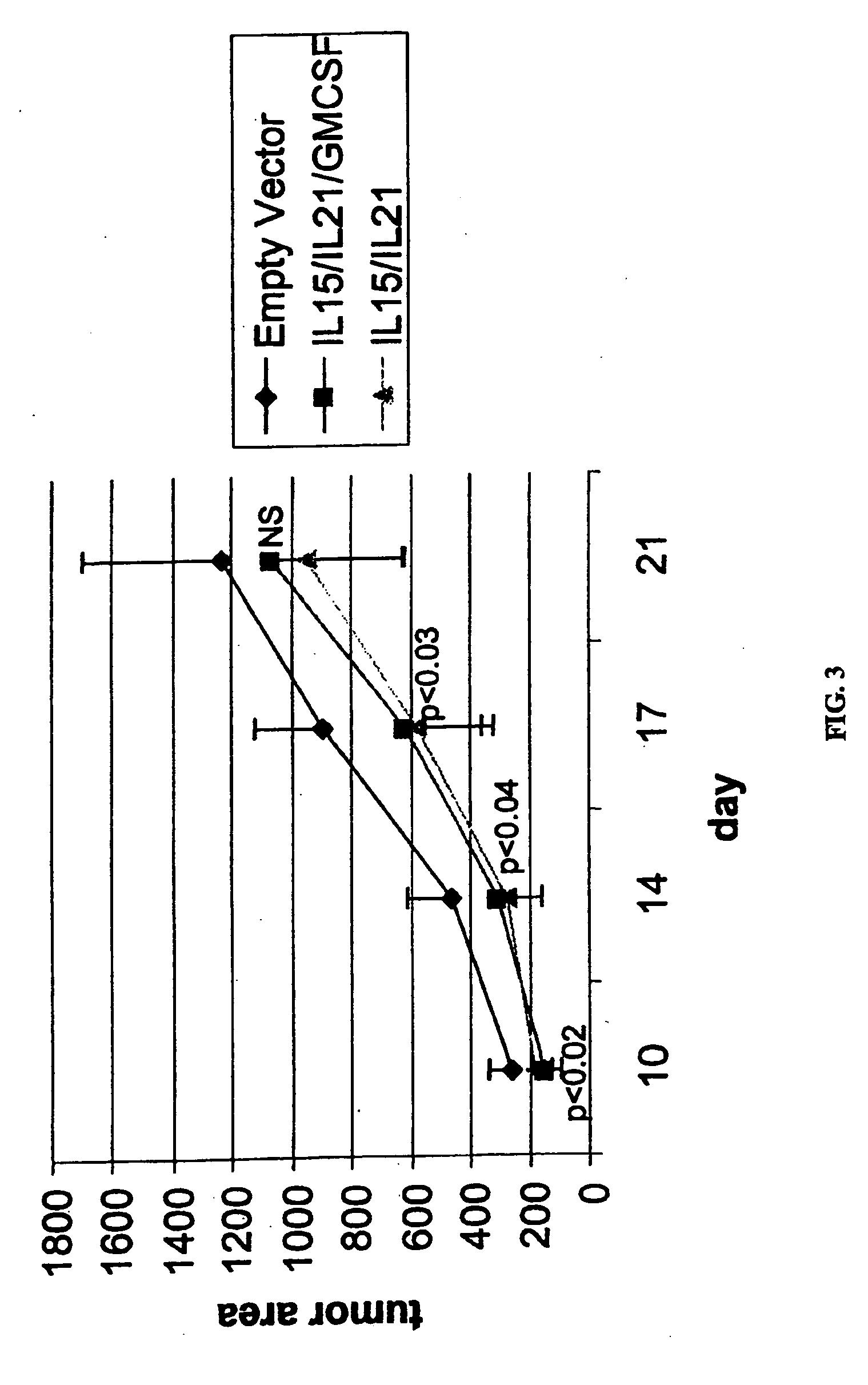Genetically modified tumor cells as cancer vaccines
a tumor cell and gene technology, applied in the field of cell biology, cancer biology, immunology, can solve the problems of ineffective use of electroporation in the treatment of cancer, and the country's health problem continues to be significant, and achieves the effect of improving the efficiency of treatment and improving the survival ra
- Summary
- Abstract
- Description
- Claims
- Application Information
AI Technical Summary
Benefits of technology
Problems solved by technology
Method used
Image
Examples
example 1
[0191] Transfection of renal carcinoma cells (RENCA) was optimized using the marker gene eGFP containing DNA plasmid. Under optimal conditions, greater than 80% of the transfected RENCA cells expressed eGFP as analyzed by FACS 24 hours post electroporation.
[0192] Mouse IL-12, IL-21, IL-15 and GM-CSF full-length cDNA were each subcloned into a commercially available DNA plasmid, pVAX (Invitrogen), in which the transgene is regulated by the CMV promoter.
[0193] Young Balb / C mice (˜8 week of age) from Jackson Laboratory were first injected subcutaneously with 5e5 RENCA cells, on their left side. Seven days later, mice with established tumors were randomly divided into 5 groups, 8 mice for each group. Then the mice were subcutaneously injected on their right side (remote from primary tumor site) one time with 5e5 electroporated RENCA cells, which were transfected with the cytokine combinations as following: IL-12 / IL-21 / GM-CSF, IL-12 / IL-15 / IL-21, IL-12 / IL-15 / GF-CSF, and IL-15 / IL-21 / GM-C...
example 2
[0196] Further experiments were performed to evaluate the anti-tumor effect of RENCA cells modified with GM-CSF, IL-15 and IL-21, alone and in various combinations. As in Example 1, primary tumors were established in Balb / C male mice by sub-cutaneous injection with 5e5 unmodified RENCA cells. Each mouse was ear-tagged to allow for continuous monitoring. Injections were administered in the rear, left backs of shaved mice. The tumors typically follow a predictable progression, being detectable by day 5 and readily measured by day 6-7. On day 7, tumors were measured by digital calipers and only those mice with statistically identical tumor areas were used. This ensures an equivalent baseline tumor area. Mice were then sorted into 9 groups of 10 mice.
[0197] RENCA cells were electroporated with various combinations of plasmid DNA encoding cytokine genes. The genes selected for this study were mGM-CSF, mIL-15 and mIL-21. Each transgene was contained on identical plasmid backbones contain...
example 3
Materials and Methods:
[0212] B-CLL Cells. After informed consent was obtained, peripheral blood was collected from CLL patients at Washington Cancer Institute (Washington, D.C.) or at Baylor College of Medicine (Houston, Tex.). B-CLL cells were isolated by standard Ficoll Paque gradient separation procedure. Briefly, the total peripheral blood was first diluted with equal volume of PBS (BioWhittaker, Md.) containing 10 mM NaCitric (Sigma, St. Louis, Mo.) prior to being layered atop of Ficoll Paque in a 50 mL conical tube. After 20 minutes centrifugation at 160×g without braking, the cells at the interphase were collected, washed twice with PBS, and then cryopreserved. A small fraction of the cells were saved and characterized by flow cytometry. Generally, FACS analysis of cell surface markers revealed greater than 90% of the cell population were CD5 / CD19 double positive.
[0213] Antibodies and Reagents. Fluorescein isothiocyanate (FITC)-conjugated monoclonal antibody (Mab) specific...
PUM
| Property | Measurement | Unit |
|---|---|---|
| time | aaaaa | aaaaa |
| volume | aaaaa | aaaaa |
| concentration | aaaaa | aaaaa |
Abstract
Description
Claims
Application Information
 Login to View More
Login to View More - R&D
- Intellectual Property
- Life Sciences
- Materials
- Tech Scout
- Unparalleled Data Quality
- Higher Quality Content
- 60% Fewer Hallucinations
Browse by: Latest US Patents, China's latest patents, Technical Efficacy Thesaurus, Application Domain, Technology Topic, Popular Technical Reports.
© 2025 PatSnap. All rights reserved.Legal|Privacy policy|Modern Slavery Act Transparency Statement|Sitemap|About US| Contact US: help@patsnap.com



